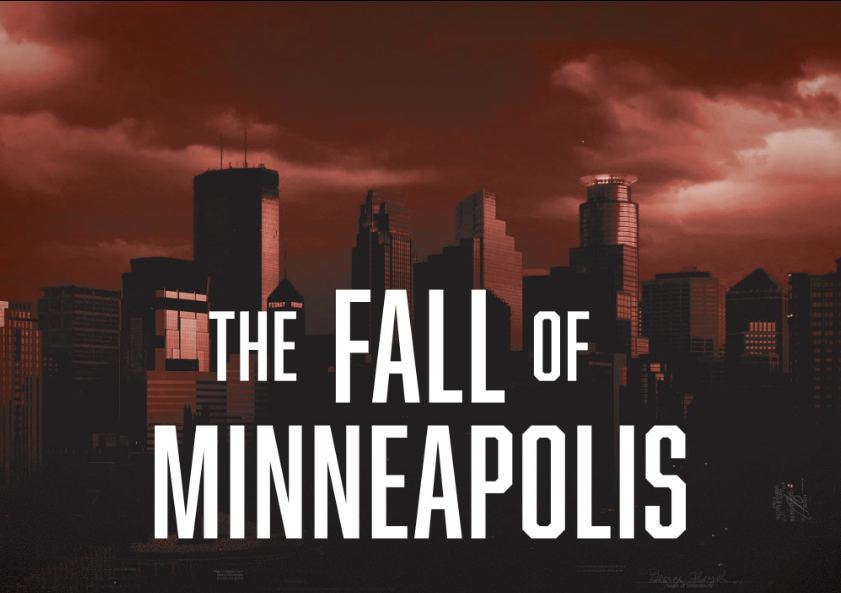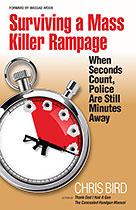The Fall of Minneapolis
Reviewed by Gila Hayes
Have you watched the documentary from Alpha News about the death of George Floyd and subsequent destruction? I viewed it several months ago, on Thanksgiving as a matter of fact, while I was dicing the celery, carrots and onions and doing other food prep. Did the onions bring the tears to my eyes? Probably not, but some of the documentary does make the watcher want to weep.
T hanksgiving Day was busy and I’d forgotten about the video until Judicial Watch’s Chris Farrell’s On Watch podcast featured an interview with Liz Collin, who produced and conducted the interviews in The Fall of Minneapolis. Much public criticism has followed the release of the documentary. I try hard to read and listen to news from neutral sources, so I’m not a regular content consumer at Alpha News.
hanksgiving Day was busy and I’d forgotten about the video until Judicial Watch’s Chris Farrell’s On Watch podcast featured an interview with Liz Collin, who produced and conducted the interviews in The Fall of Minneapolis. Much public criticism has followed the release of the documentary. I try hard to read and listen to news from neutral sources, so I’m not a regular content consumer at Alpha News.
Unfortunately, the documentary suffers criticism for being an Alpha News production. That’s regrettable because there is a wealth of insight in Collin’s interviews with investigators, police officers who fled Minneapolis’ Third Precinct after the command to surrender it, as well as other victims of the chaos. The full profile of George Floyd’s history and the fentanyl, methamphetamine and cannabinoids in his system, coupled with the body cam footage of officers who responded to the Cup Food clerk’s call about a customer who refused to return merchandise for which he paid with a counterfeit bill.
That’s just a little taste of The Fall of Minneapolis, available free at https://www.thefallofminneapolis.com/, on YouTube, or on Rumble. Is it 100 percent accurate? Who knows? Was the national news reportage of Floyd’s death, the riots, and the trials of the police officers accurate? Oh, heck no, it was not. In The Fall of Minneapolis, video footage of police contact with Floyd, interviews with people who were present at the incident and in the chaos of the days and weeks to follow, helps fill in the details for a truer picture of events, the way elected officials fanned the flames, and the losses the city’s residents suffered.
Surviving a Mass Killer Rampage:
When Seconds Count, Police Are Still Minutes Away
By Chris Bird, Foreword by Massad Ayoob
432 pages, paperback
ISBN-13: 978-0983590194
Privateer Publications (August 1, 2016)
Sold used on Amazon and other used book sellers
Ordinarily, I would not review an out of print book, but my interview with Ed Monk took me back to a book on spree shootings and mass shooting events that I’d read several years ago. Some of our fellow armed citizens are as reactive to the term “active shooter” as I am to the term “gun violence” (as if inanimate objects can act without a living thing’s intervention) and in searching for the terminology my friend, the noted author Chris Bird, prefers, I found myself drawn into his book Surviving a Mass Killer Rampage.
Bird also asserted that the term gun free zone is a lie, since “they are only free of law-abiding citizens with guns.” Massad Ayoob wrote the foreword and added that so-called gun free zones are actually hunting preserves for killers because victims can’t fight back.
While mass killing rampages have occurred in shopping malls, restaurants, theaters, clubs, churches and other public venues, school shootings are among the most disturbing. Arming teachers puts armed defenders on the scene for timely intervention, as Monk pointed out, a solution Bird was promoting in 2016 in Surviving a Mass Killer Rampage, which combined extensively researched post-incident interviews with citizen defenders and material from Tactical Defense Institute’s active-killer defense classes, plus other school shooting response programs.
Bird further addressed Muslim jihad and mass killings outside of gun free zones but stressed his disinterest in the killer’s motivation. A lifetime professional journalist, he applied Who, What, When, Where and How, to emphasize what to watch for and how to react if caught in a mass shooting attack.
Bird’s chapters, stories and vignettes showed the decisive stop an armed citizen can affect when a killer attacks a crowd, but he wrote that willingness to act is more important. He told the story of Springfield, OR student Jake Ryker who stopped a school shooter who had killed two and wounded 25, which we mentioned briefly in this month’s interview with Ed Monk. When the killer’s rifle clicked on an empty chamber, Ryker and his brother immobilized him before the killer could reload or grab a pistol or knife.
Bird quoted the late Bill Barchers’ study of active killers in which that researcher asserted that of 49 such incidents, nine were resolved by police while the intended victims confronted the shooter and stopped the killing 14 times, with “minimum loss of life.” What a contrast to the common sentiment that citizens should just call 9-1-1 and wait for help.
Rallying police is always too slow, Bird showed, citing reports about school killings at the Columbine, CO high school and on other campuses. He wrote it is likely that the shooter will attack during daylight hours, probably inside a building, will know the area and target specific people initially before the rampage turns indiscriminate. The murderers generally commit suicide, either killing themselves or forcing responders to kill them.
As Ed Monk told us in his interview, Bird wrote that only onsite personnel are likely to stop the killing, which he supported by studying police response at VA Tech in April 2007 where nearly two dozen were killed and many more injured although police responded about eight minutes after the first 9-1-1 call for help.
Through the lens the VA Tech killings, Bird also discussed the question of fleeing or fighting a mass killer attack. He evaluated barricading or locking doors, playing dead and hiding under desks. Only two years earlier, he revealed, a VA Tech student was disciplined for having a gun on the VA Tech campus, despite having a concealed carry license. Contrast this, Bird urged, with the armed, life-saving actions of the Pearl, MS high school assistant principal who stopped a student/killer in 1997, as well as the 2002 armed response of Tracy Bridges who with another armed student subdued a man who shot a student, a professor and the school dean at the Appalachian School of Law.
Armed teachers, students, parishioners, and other armed citizens can and do stop killers seeking infamy through mass murder. Consider the New Life Church in CO where Jeanne Assam engaged an active killer, and in another parish in which the pastor had to shoot a janitor bent on revenge after losing his job.
Bird’s analyses were genuine studies, not pro-gun propaganda and when armed defenders run into difficulties, be that through tactical mistakes, inadequate skill or the inevitable confusion at a mass shooting scene, Bird plainly reported what happened.
Bird showed how seriously disorienting post-incident confusion can be. Joe Zamudio, running to try to stop the shooter who attacked Gabrielle Giffords, encountered a tremendously confusing scene, with another citizen holding the disarmed attacker’s gun and nearly being shot as a result. Bird wrote honestly about the good, the bad and the ugly elements people have gone through interdicting mass killer rampages. Still, he asserted that anti-gun hype that armed citizens will harm more innocents is unfounded. This supposition, he wrote, “has been used to disarm ordinary citizens in stores, movie theaters, malls, schools, colleges, and on the street. It hasn’t happened, but what has happened is that active killers choose so-called gun free zones, including churches to commit their atrocities.”
Additional chapters in Surviving a Mass Killer Rampage discussed threats from radical Islam illustrated by the attacks in Mumbai, London, Madrid, the U.S., and France. Today, even more than when Bird wrote it, we recognize that organized terrorism is formidable, not only in weaponry–ranging from handguns to rifles to explosives–but undertaken by teams of assailants sent out to commit dramatic, atrocities. He also analyzed the San Bernardino, Ft. Hood, and Chattanooga attacks, noting that in all three, the terrorists carried huge quantities of ammunition and multiple firearms.
Bird studied various terror incidents, several in which unarmed citizens stopped the danger as did the four young American men on the Paris-bound train out of Amsterdam that came under attack by a heavily-armed terrorist, whom they physically subdued. Jihadists don’t always use guns, Bird illustrated when he wrote about the 2014 beheading a fired food processing plant employee committed in the name of Allah near Oklahoma City. He was stopped by a manager with a gun.
Bird dubbed armed citizens “irregular first responders,” in the war against terror and mass killers. He closed his chapter on terrorism on American soil with a call to be trained in firearms use and where lawful, carry your gun concealed without fail. The armed citizen is the first line of defense, he stressed. Surviving a Mass Killer Rampage is a great resource for further study into the topic about which we interviewed Ed Monk this month. In addition to being very informative, like all of Bird’s books it is a compendium of pertinent stories and it makes enjoyable and educational reading.
